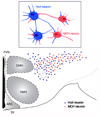Electrophysiological effects of MCH on neurons in the hypothalamus
- PMID: 19463877
- PMCID: PMC2782585
- DOI: 10.1016/j.peptides.2009.05.006
Electrophysiological effects of MCH on neurons in the hypothalamus
Abstract
Melanin concentrating hormone (MCH) has been implicated in many brain functions and behaviors essential to the survival of animals. The hypothalamus is one of the primary targets where MCH-containing nerve fibers and MCH receptors are extensively expressed and its actions in the brain are exerted. Since the identification of MCH receptors as orphan G protein coupled receptors, the cellular effects of MCH have been revealed in many non-neuronal expression systems (including Xenopus oocytes and cell lines), however, the mechanism by which MCH modulates the activity in the neuronal circuitry of the brain is still under investigation. This review summarizes our current knowledge of electrophysiological effects of MCH on neurons in the hypothalamus, particularly in the lateral hypothalamus. Generally, MCH exerts inhibitory effects on neurons in this structure and may serve as a homeostatic regulator in the lateral hypothalamic area. Given the contrast between the limited data on cellular functions of MCH in the hypothalamus versus a fast growing body of evidence on the vital role of MCH in animal behavior, further investigations of the former are warranted.
Figures


Similar articles
-
Melanin concentrating hormone depresses synaptic activity of glutamate and GABA neurons from rat lateral hypothalamus.J Physiol. 2001 May 15;533(Pt 1):237-52. doi: 10.1111/j.1469-7793.2001.0237b.x. J Physiol. 2001. PMID: 11351031 Free PMC article.
-
Regulation of synaptic efficacy in hypocretin/orexin-containing neurons by melanin concentrating hormone in the lateral hypothalamus.J Neurosci. 2008 Sep 10;28(37):9101-10. doi: 10.1523/JNEUROSCI.1766-08.2008. J Neurosci. 2008. PMID: 18784290 Free PMC article.
-
Melanin-concentrating hormone depresses L-, N-, and P/Q-type voltage-dependent calcium channels in rat lateral hypothalamic neurons.J Physiol. 2002 Jul 1;542(Pt 1):273-86. doi: 10.1113/jphysiol.2002.019372. J Physiol. 2002. PMID: 12096069 Free PMC article.
-
Physiological arousal: a role for hypothalamic systems.Cell Mol Life Sci. 2008 May;65(10):1475-88. doi: 10.1007/s00018-008-7521-8. Cell Mol Life Sci. 2008. PMID: 18351292 Free PMC article. Review.
-
MCH and feeding behavior-interaction with peptidic network.Peptides. 2009 Nov;30(11):2045-51. doi: 10.1016/j.peptides.2009.07.008. Epub 2009 Jul 18. Peptides. 2009. PMID: 19619600 Review.
Cited by
-
Melanin-concentrating hormone neurons release glutamate for feedforward inhibition of the lateral septum.J Neurosci. 2015 Feb 25;35(8):3644-51. doi: 10.1523/JNEUROSCI.4187-14.2015. J Neurosci. 2015. PMID: 25716862 Free PMC article.
-
Melanin-Concentrating Hormone (MCH): Role in REM Sleep and Depression.Front Neurosci. 2015 Dec 17;9:475. doi: 10.3389/fnins.2015.00475. eCollection 2015. Front Neurosci. 2015. PMID: 26733789 Free PMC article. Review.
-
Identification of Candidate Genes for Min Pig Villi Hair Traits by Genome-Wide Association of Copy Number Variation.Vet Sci. 2023 Apr 23;10(5):307. doi: 10.3390/vetsci10050307. Vet Sci. 2023. PMID: 37235390 Free PMC article.
-
Integrating GHS into the Ghrelin System.Int J Pept. 2010;2010:879503. doi: 10.1155/2010/879503. Epub 2010 Mar 18. Int J Pept. 2010. PMID: 20798846 Free PMC article.
-
The Lateral Hypothalamus: An Uncharted Territory for Processing Peripheral Neurogenic Inflammation.Front Neurosci. 2020 Feb 12;14:101. doi: 10.3389/fnins.2020.00101. eCollection 2020. Front Neurosci. 2020. PMID: 32116534 Free PMC article. Review.
References
-
- Abbott CR, Kennedy AR, Wren AM, Rossi M, Murphy KG, Seal LJ, Todd JF, Ghatei MA, Small CJ, Bloom SR. Identification of hypothalamic nuclei involved in the orexigenic effect of melanin-concentrating hormone. Eur J Pharmacol. 2003;475:37–47. - PubMed
-
- Audinot V, Beauverger P, Lahaye C, Suply T, Rodriguez M, Ouvry C, Lamamy V, Imbert J, Rique H, Nahon JL, Galizzi JP, Canet E, Levens N, Fauchere JL, Boutin JA. Structure-activity relationship studies of melanin-concentrating hormone (MCH)-related peptide ligands at SLC-1, the human MCH receptor. J Biol Chem. 2001;276:13554–13562. - PubMed
-
- Baker BI, Eberle AN, Baumann JB, Siegrist W, Girard J. Effect of melanin concentrating hormone on pigment and adrenal cells in vitro. Peptides. 1985;6:1125–1130. - PubMed
-
- Ballon JS, Feifel D. A systematic review of modafinil: Potential clinical uses and mechanisms of action. J Clin Psychiatry. 2006;67:554–566. - PubMed
Publication types
MeSH terms
Substances
Grants and funding
LinkOut - more resources
Full Text Sources
Molecular Biology Databases

